The Winter Consumer Electronics Show
A Turning Point For
Atari?
Tom R. Halfhill, Editor
Following up its strong showing at the Comdex computer show in November, Atari introduced a more powerful version of its ST at the Winter Consumer Electronics Show in January. Thanks to increasing sales, growing software support, widening distribution, and hints of new enhancements to come, industry watchers are suddenly taking more notice of Atari's bid for a comeback. Meanwhile, Commodore also entered 1986 with encouraging sales and Apple is responding with an improved Macintosh and lower prices.
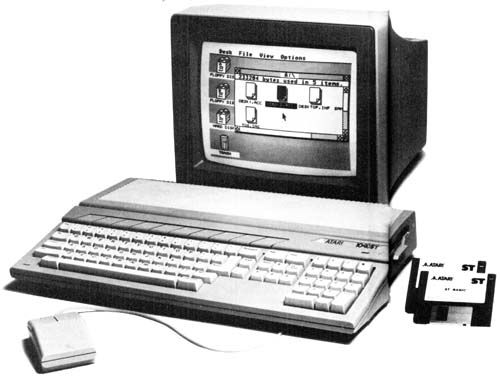
The
new Atari 1040ST is the first one-
megabyte computer for under $1,000. It
has 1,024K of RAM and a built-in,
double-sided disk drive.
megabyte computer for under $1,000. It
has 1,024K of RAM and a built-in,
double-sided disk drive.
A year ago it seemed impossible. Commodore founder Jack Tramiel had split with his successful computer company after a management dispute, bought the debt-ridden Atari that he had nearly destroyed in price wars, installed his sons in key positions, laid off most of the work force, rushed the design of a powerful 16/32-bit machine in only six months, introduced it at an unheard-of low price, and announced he was going to resurrect Atari as a major contender in the personal computer marketplace.
Atari still isn't home free. But the house that Jack built suddenly seems a lot more solid.
Strengthened by encouraging sales of the 520ST-according to estimates, at least 100,000 units worldwide through Christmas-Atari is now attracting more attention within the industry. "Frankly, a lot of people didn't think Jack would make it this far," says one observer. "Now they're taking him a lot more seriously."
If Atari's comeback ultimately succeeds, the six-week period between late November 1985 and early January 1986 may well become recognized as the turning point. During that period, Atari piled up sizeable holiday sales and made impressive appearances at two crucial industry trade shows: Fall Comdex and the Winter Consumer Electronics Show. Both are held annually in Las Vegas and are among the largest trade shows in the U.S., with upwards of 100,000 people at each event.
At Comdex, which is oriented toward business computing, Atari demonstrated to skeptics that its 520ST was a real machine with dozens of software packages. At CES, a show that encompasses every consumer electronics product imaginable, Atari was the only major computer manufacturer in attendance and made three important announcements: the new 1040ST, a more powerful version of the 520ST with one megabyte of memory and a built-in disk drive; price reductions of $100 for the monochrome and color 520ST systems; and a shift to mass-market outlets such as department stores for the 520ST.
Atari's appearances at Comdex and CES seemed all the more impressive due to the conspicuous absence of its closest competitor, Commodore. People were surprised when Commodore missed Comdex because the company has been trying to position the Amiga as a business computer and Comdex was the ideal place. But there was shock when Commodore bowed out of CES because Commodore has never missed a CES since the days when wristwatches and calculators were its stock in trade.
Commodore didn't have much to say about missing the shows. However, one Commodore executive admitted he was "uneasy" about the reaction at CES-ironically, the rumors of imminent financial catastrophe that once followed Atari were now being whispered about Commodore. The rumors proved untrue, however, and Commodore says it definitely plans to attend the Summer CES in Chicago this June.
Actually, Commodore finished 1985 with heavy sales of its own. According to reliable estimates, Commodore sold about one million 64s, as many as 500,000 Commodore 128s, and at least 20,000 Amigas. Even Commodore was caught off guard by the 64 and 128 sales. In fact, insiders say Commodore tried twice during the fall to discontinue the 64, but had to restart production both times to meet sudden demand. As an indication that Amiga sales are healthy, the leading independent software supplier for the computer-Electronic Arts-says it recovered all of its 1985 Amiga development costs within two weeks after releasing its first Amiga products.
Although Atari and Commodore are still struggling financially, both have survived a rough market in 1985 and appear to be in better shape for 1986.
Since Atari was the only major computer company exhibiting at CES (IBM and Apple routinely avoid this show), most of the computer news was Atari-related. The main event was the introduction of the 1040ST, the first one-megabyte computer selling for under $2,500. In fact, it's the first one-megabyte computer selling for under $1,000.
The 1040ST is basically an enhanced 520ST and is fully compatible with existing ST software and hardware. The keyboard and all interfaces are identical: RS-232 serial and Centronics-standard parallel ports; in/out MIDI (Musical Instrument Digital Interface); floppy and hard disk interfaces; plus monochrome and analog RGB monitor outputs. The graphics-oriented user interface, GEM (Graphics Environment Manager), is the same.
New features on the 1040ST include one megabyte (1,024K) of Random Access Memory (RAM), twice the amount that comes with the 520ST; a built-in, double-sided 3½-inch disk drive with a capacity of 770K per disk, twice the capacity of the drive sold with the 520ST; a TV output jack; and an internal power supply for both the computer and drive, reducing the familiar clutter of external cables.
Like recent-model 520STs, the 1040ST comes with its Tramiel Operating System (TOS) in Read Only Memory (ROM) chips, freeing up more than 200K RAM that used to be required when loading TOS from disk. Also like the 520ST, the 1040ST comes with ST BASIC, the NEOchrome graphics-drawing program, and a word processor, 1st Word (the 520ST comes with ST Writer). Atari says 1st Word has GEM features such as drop-down menus and on-screen type fonts. (ST Writer, by contrast, is a direct translation from the AtariWriter word processor for eight-bit Ataris.)
There are two different 1040ST packages. With a high-resolution monochrome monitor, the suggest ed retail price is $999.95. With an analog RGB color monitor, the price is $1,199.95. Atari says the 1040ST will be sold only through computer dealers and should be available immediately.
The 520ST also underwent some minor changes. The latest models will be shipped with TOS in ROM and a TV output jack. To widen distribution, the 520ST will be sold through massmarket outlets in three different ways. A system that includes the computer, a single-sided 3½-inch disk drive (380K capacity), and hires monochrome monitor will now be priced at $699 suggested retail. The same system with an analog RGB color monitor instead of the monochrome screen will be priced at $899. Both prices are $100 lower than before. The 520ST components are also available separately: $399 for the computer, $199 for a single-sided drive, $299 for a double-sided drive, $199 for the monochrome monitor, and $299 for the RGB monitor.
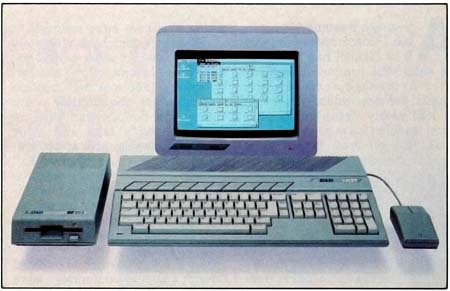
a TV output jack, and a $100 lower price. Also, for the first time, the
computer and other components will be available separately in
mass-market outlets.
Rumors abounded at CES about new developments for the ST line, including a better graphics chip, a bit-block transfer chip similar to the one in the Amiga, a 5¼-inch disk drive adapter for use with an IBM PC emulator, and more. Officially, Atari won't confirm or deny if it's preparing to introduce any of these products in the near future.
However, Atari is expected to announce at least one enhancement at an upcoming computer show in West Germany (about half of all ST sales are in Europe). The most likely possibility is the bit-block chip, which allows faster screen graphics. Also, it is now known that three companies outside Atari are working on PC emulators for the ST, each taking a slightly different approach. At this writing (mid-January), none of them is expected to be ready for several months.
Atari's CES exhibit poked fun at the Amiga and Apple Macintosh by lining up a series of computers running the now-famous Amiga bouncing ball demo. (A screen photo of this demo appears in COMPUTE!'s cover story on the Amiga in September 1985; it shows a red-and-white checkered globe spinning and bouncing around the screen, casting a transparent shadow on the background.) An Amiga, 520ST, Macintosh, and eight-bit Atari 130XE spent four straight days dribbling checkered balls at the Atari booth. Oddly enough, the 130XE version was perhaps the most impressive of all. Not only was the 130XE bouncing a checkered ball, but also a 3-D image of the Atari logo decorated with 128 rippling colors.
Apple hasn't been oblivious to the competition, and a week after CES announced an improved version of the Macintosh and lower prices for the 512K Mac. The new Macintosh Plus has one megabyte of RAM, a double-sided disk drive that stores 800K (twice the capacity of existing Macintosh drives), a redesigned keyboard with numeric keypad and cursor keys, a faster operating system, and an extra peripheral port called the Small Computer System Interface. The suggested retail price is $2,599. The 512K Mac was reduced from $2,499 to $1,999, and kits are available so owners of 128K and 512K Macs can upgrade to the Mac Plus.
Atari didn't ignore its older products at CES. Among other things, two new eight-bit computer packages were unveiled.
The 130XE, a 400/800/XLcompatible computer with 128K RAM that was introduced last year, will now be available in a $399 package that includes a 1050 disk drive, 1027 printer, and five pieces of software: AtariWriter, Music Painter, Paint, Star Raiders, and Silent Butler. The 130XE is still available separately for $149.
Atari's new lowest-end computer is the 65XE, a 400/800/XLcompatible machine with 64K RAM. It was actually announced at last year's Winter CES, but was withheld from the market until existing inventories of 800s and 800XLs were sold out. The 65XE will be sold separately for under $100 or in a package similar to the 130XE's for $300-$350.
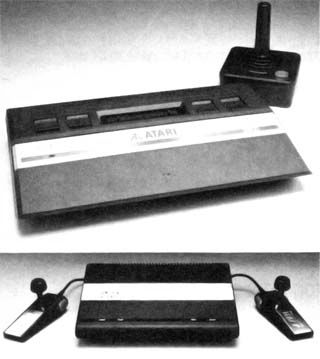
Relics from another age? Nope. Video-game
machines are still selling so well that Atari
has redesigned the nine-year-old 2600 and
introduced a new model, the 7800.
Much to everyone's surprise, Atari also came to CES with a redesigned 2600 videogame machine (formerly known as the VCS) and the new 7800 game machine. What's that, you thought videogame machines were dead? Guess again. Atari says it sold over a million 2600s in 1985. Apparently many of them are going to new markets overseas-including, we hear, the People's Republic of China.
The revamped 2600 is smaller, lighter, sleeker, has a carrying handle, and costs less than $50. The 7800 machine was one of the last projects of the old Atari before Tramiel took over, and is now being unpacked from mothballs. Thanks to a chip named MARIA, the 7800's graphics are superior even to those of the eight-bit computers, and the machine accepts all 2600 cartridges without an adapter. It sells for less than $80 and comes with a new version of Pole Position, the hit car racing game.
Computers aren't much good without software, and Winter CES demonstrated that a lot of companies are bringing out new programs for the ST and Amiga as well as popular eight-bit machines. Unfortunately, there were a lot fewer software companies at this CES than last year's. The West Hall, a large building which supplements the main Convention Center, once was filled with software publishers. This year, only a handful of them shared space with companies selling satellite dishes, videotapes, cable TV accessories, and other periphernalia. The last two years have been tough, and many software developers either can't afford to exhibit at CES anymore or are out of business altogether.
Still, some fascinating products are on the way. Starting with ST and Amiga software, here's what's new:
 Electronic Arts (San Mateo, California) announced several new
programs for the Amiga and its first products for the Atari ST. New
Amiga software slated for release this year includes Deluxe Music, a note-oriented
composition program; Instant Music,
a composition program for nonmusicians; Arcticfox, a strategic combat tank
simulation; Adventure Construction
Set, for do-it-yourself adventure games; and Deluxe Printing Construction Set.
Electronic Arts (San Mateo, California) announced several new
programs for the Amiga and its first products for the Atari ST. New
Amiga software slated for release this year includes Deluxe Music, a note-oriented
composition program; Instant Music,
a composition program for nonmusicians; Arcticfox, a strategic combat tank
simulation; Adventure Construction
Set, for do-it-yourself adventure games; and Deluxe Printing Construction Set.A previously announced Electronic Arts program, Deluxe Video Construction Set, is due for release soon. It lets you create animated sequences that can be integrated with screens created in DeluxePaint, a drawing program released in December. (Electronic Arts says it shipped 15,000 copies of DeluxePaint the first two weeks.) Scores composed with Deluxe Music can also be integrated with Deluxe Video Construction Set.
ST software from Electronic Arts includes two programs already released for the Amiga: Financial Cookbook, a home financial planner, and Marble Madness, an arcade game. Prices for Electronic Arts' Amiga and ST software range from $39.95 to $79.95.
Hippopotamus Software (Los Gatos, California) is bringing out the Hippo ST Sound Digitizer and Hippovision Video Digitizer for the Atari ST. The sound digitizer plugs into the printer port and lets you sample, modify, and play back any type of sound. It includes specialeffects software and a microphone for $139.95. The video digitizer lets you capture images in 256 X 256 - pixel resolution from any composite video source, such as a video camera, videocassette recorder, videodisc player, or TV tuner. Picture files are compatible with Atari's NEOchrome drawing program, can be printed on color printers, and can be transmitted via modem. The price was not announced.
Hippopotamus has 13 other ST programs scheduled for release soon, including HippoWord, an $89.95 word processor; HippoConcept, an idea processor, $89.95; HippoSimple, a database manager, $49.95; Hippo Disk Utilities, $49.95; HippoBackgammon, $39.95; HippoSpell, a spelling checker with 30,000-word dictionary and userdefinable terms, $39.95; Hippo RAMdisk, $34.95; Hippo Computer Almanac, which contains over 35,000 facts on everything from area codes to sports trivia, $34.95; Hippo Jokes & Quotes, with selectable PG, R, or X ratings, $34.95; HippoArt I, a collection of 30 picture files compatible with NEOchrome, $39.95; Hippo EPROM Burner, for programming your own chips, $139.95; HippoClean, a disk drive cleaning kit, $29.95; and HippoPixel, a utility for creating your own sprites and fonts, $39.95.
Aegis Development (Santa Monica, California) is bringing out four graphics products for the Amiga: Aegis Images, a drawing program; Aegis Draw, a ComputerAided Design (CAD) program; Aegis Animator, for creating animated sequences; and Impact, an executive graphics package. Images, Animator, and Impact were actually developed by Island Graphics of Sausalito, California. Under an agreement with Commodore, they were supposed to be released under the Amiga brand name. For instance, Images was originally known as Graphicraft or ProPaint (several screens created with this program appear on the Amiga's packaging and in the September 1985 issue of COMPUTE!). But Island Graphics and Commodore had a falling out, and the Amiga Graphicraft currently being sold is not the software developed by Island Graphics. Instead, Aegis acquired the marketing rights to the Island Graphics programs, enhanced them, and renamed them Aegis Images, Animator, and Impact.
Images is available for $79.95 separately, or for $139.95 in a package with Aegis Animator. Using Images screens as a backdrop, Animator allows 3-D animation and rotation, metamorphic shape manipulation, storyboarding of up to nine separate sequences, and ghost-line animation. Impact ($199.95) is for business presentation graphics and includes a slide show feature-charts, graphs, and pictures can be flipped in a predetermined sequence and transformed.
Aegis Draw, for hobby and professional CAD work, actually consists of two programs: Aegis Draw and Aegis Draw Professional. The first version retails for $199.95 and can be upgraded to the Professional version at extra cost. Aegis Draw has zooming, automatic scaling, selectable grids, layering, and multiple windows so you can work on several drawings simultaneously, or on different parts of the same drawing. It supports Kurta and Summagraphics digitizers, and plotters by Roland, Hewlett Packard, Houston Instruments, Epson, and Comrex. All four Aegis programs for the Amiga should be available immediately.
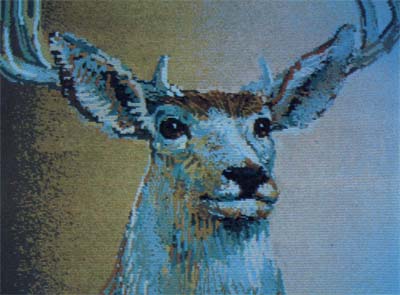
This strikingly beautiful picture was created on the Amiga's
320 X 200-pixel screen in 32 colors with Aegis Images, a
graphics-art program demonstrated at CES.
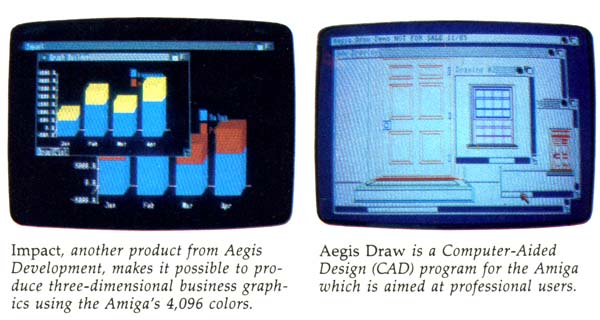
Supra Corporation (Albany, Oregon) announced a series of hard disk drives for the Atari ST with capacities of 10, 20, 40, and 80 megabytes. Prices start at $799 for 10 megabytes. They should be available this spring.
Optimized Systems Software (San Jose, California) was demonstrating Personal Pascal for the ST at the Atari booth and has already started shipping. This language supports all of the ST's special features, compiles and links most programs in about a minute (even faster with a hard disk or RAM disk), and sells for $74.95 OSS is also readying a version of the Prolog language and a set of disk utilities for the ST.
Cardco (Wichita, Kansas), known in the past for its VIC-20 and Commodore 64 add-ons, is preparing a one-megabyte memory expansion board for the Amiga. The board plugs into the expansion bus, and Cardco says it will be available this spring for about $400.
Unison World (Berkeley, California) is converting PrintMaster a printer utility similar to The Print Shop-to the Atari ST. It's already available for the Commodore 64, IBM, and CP/M computers.
Activision (Mountain View, California) said sales of its initial software for the ST and Amiga have been "quite strong" and that additional titles will be released this year. These include Garry Kitchen's GameMaker: The Computer Game Design Kit and The Music Studio for the Amiga and ST; and The Activision Little Computer People Discovery Kit for the Amiga. GameMaker lets you write videogames without learning a programming language. Finished games can be saved on a blank disk and run independently of the master program, so you can distribute copies to friends. Activision is sponsoring a GameMaker contest-first prize is a trip to Activision plus $5,000.
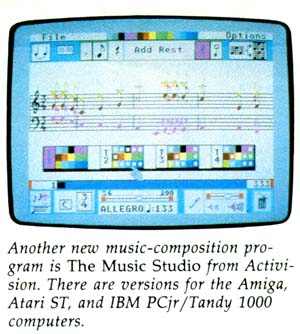
The Music Studio is a composition tool designed by Audio Light for both amateur and professional musicians. With it, you can design instruments and create new sound effects. The Amiga version plays up to 16 simultaneous sound channels in stereo.
Accolade/FTL Games (Cupertino, California) has released Sundog: Frozen Legacy for the ST. Originally written for the Apple II series, Sundog is a graphics strategy game that has been completely redesigned to take advantage of the ST's advanced graphics. Thanks to a proprietary data-compression scheme, hundreds of different fullcolor screens are stored on the program disk.
Mindscape (Northbrook, Illinois) is introducing three programs for the Amiga and one for the ST. Brataccas ($49.95) is a graphics adventure game for both computers that was developed by Psygnosis Limited of England. It was written specifically to take advantage of the 68000 chip inside the Amiga and ST. In Brataccas, you're a scientist who has invented a genetic process for creating a superbeing. With an evil government and the underworld in pursuit, you flee to a colonized asteroid, Brataccas. The object is to expose the government's corruption and clear your name. Brataccus is populated with nearly 60 different characters.

For the Amiga only, Mindscape is releasing The Halley Project: A Mission in Our Solar System ($49.95), a realtime simulation of the solar system developed by Tom Snyder Productions with help from the Massachusetts Institute of Technology; Deja Vu: A Nightmare Come True ($54.95), a 1940s-style mystery game; and Keyboard Cadet ($39.95), a typing tutor. (Incidentally, Mindscape is the company which wrote the Amiga Tutor supplied with the Amiga.)
Abacus Software (Grand Rapids, Michigan) is importing a professional-quality program called PC Board Design for the ST. When Abacus finishes translating this circuitdesigning utility from German, it will sell for $395.
Batteries Included (Richmond Hill, Ontario) was demonstrating its D.E.G.A.S. drawing program for the ST with a slideshow of screens called up in rapid sequence from a hard disk. D.E.G.A.S. started shipping just before CES, and it's already a hit-Batteries Included says that sales figures for the first two weeks were greater than for any other program in its history. ST and Amiga versions of the Isgur Portfolio System, a stock-management program, are scheduled for release later this year at $249.95.
Q-R-S (Buffalo, New York), a company that started back in 1900 by making music rolls for player pianos, is releasing its digital music library for the Amiga and ST. This consists of a number of disks containing piano music by Joplin, Gershwin, Liberace, and other artists and composers. Each disk contains six songs and sells for $19.95.
Sierra On-Line (Coarsegold, California) has converted its series of 3-D graphics adventure games for the ST: King's Quest I, King's Quest II, and Walt Disney's The Black Cauldron. The King's Quest games have been particularly popular on IBM computers.
Spinnaker Software (Boston, Massachusetts) has converted Fahrenheit 451, Treasure Island, Perry Mason, Nine Princes of Amber, Amazon, and Homework Helper Math for the ST.
The popular eight-bit computers weren't ignored by software publishers, either, and some significant new programs were announced for the Commodore 64, 128, Apple, IBM PC/PCjr, and Atari. There isn't room here to list them all, but additional information can be found in this month's "News & Products" section.
One of the biggest hits at the show was a graphics-oriented operating system in final stages of development for the Commodore 64. Called GEOS (Graphic Environment Operating System), it's modeled after the user interface popularized by the Macintosh and adapted by the Atari ST and Amiga. GEOS loads from disk and replaces the 64's normal operating system. It speeds up disk access by a factor of five to seven times and displays a desktop screen with pull-down menus, icons, and windows. You manipulate these features by moving an on-screen pointer with a mouse or joystick.
Although some people were skeptical that GEOS could run fast enough on an eight-bit machine, even the unfinished version at CES ran surprisingly smoothly. By moving the pointer to a menu bar at the top of the screen and pressing the joystick button, you can select various options for managing files and running applications (see photo). To rename a file, for instance, you pull down the File menu and choose Rename. The new filename you enter appears on the directory or beneath the program's icon. To delete a file, you point to its icon, press the joystick button, and "drag" the icon to the trash can icon. To print a file, you drag its icon to the printer icon.
The screen would get cluttered if the icons for every file were displayed at once, so GEOS lets you flip through windows as if they were pages in a book. The page number of the current window is displayed near its bottom margin. As the accompanying photo shows, GEOS uses the Commodore 64's high-resolution graphics screen to display a smaller-sized character set.

The desktop includes a full range of Macintosh-like desk accessories, such as a calculator, note pad, alarm clock, photo and text albums (for transferring data between applications), and a preferences window. The preferences window lets you adjust screen colors, change the shape and speed of the pointer, set the date and time, and so forth. The desk accessories can be called up while running other applications-if you're using the word processor and need to perform a calculation, for example, you can pop open the calculator, get your answer, close the calculator, and continue writing.
GEOS comes with two applications: geoWrite, a what-you-see-iswhat-you-get word processor that lets you type on-screen with several different proportional fonts, and geoPaint, a graphics-drawing program with vertical and horizontal scrolling that lets you create images as large as an 8½ X 11-inch page (80 dots per inch resolution).
The price for the entire package-GEOS, the desktop and desk accessories, geoWrite and geoPaint-is $59.95. It was designed by Berkeley Softworks (Berkeley, California) and is scheduled to be available early this spring.
Timeworks (Deerfield, Illinois) is releasing three new programs for the Commodore 128 and one for the 64. Partner 128 ($59.95) and Partner 64 ($49.95) are desktop management programs similar to Borland International's Sidekick for the IBM PC. Both Partner programs include a multifunction business calculator, memo pad, appointment calendar, typewriter, address book, phone book, envelope addresser, and screen printer.
SwiftCalc 128 is a spreadsheet that takes advantage of the 128's 80-column mode. It has programmable keys, multilevel sorting, and several ways of charting data (including 3-D) that can be shown on the screen or printed out. Those who already own the original SwiftCalc for the Commodore 64 can upgrade to the 128 version for a nominal fee. Timeworks has also adapted Sylvia Porter's Personal Financial Planner ($69.95) for the 128's 80-column mode.
Cardco (Wichita, Kansas) announced a Sidekick-style product, too. Called Side Saddle (Cardco is negotiating with Borland for the Sidekick name), it offers quick access to a calculator, appointment calendar, telephone directory/ dialer, memo pad, screen printer, and disk functions. It comes on a cartridge for the Commodore 64, with a 128 version to follow. Another interesting Cardco program is Freeze Frame, a screen printer that Cardco claims can capture any 64 screen on paper, even with commercial software. It works with any printer that emulates the Commodore 1525, and all Epson- and Okidata-compatibles. A 128 version of Freeze Frame is also planned.
The Commodore 128 got another boost when Cardco announced its Personal Productivity Series for the 128's CP/M mode. The first three products in the series are Personal Accountant, a financial manager for home or small business; Personal Inventory, for figuring your net worth; and Personal Time Manager, which can handle up to 26 events for as many as 240 people. Each program sells for $39.95.
In addition to software, Cardco announced three hard disk drives for the 64 and 128. Available in late March for the 64 and shortly afterward for the 128, the drives will come in 5-, 10-, and 20-megabyte capacities for $599.95, $899.95, and $1,299.95, respectively. They're capable of loading a full-function spreadsheet program in 2½ seconds.
Access Software (Salt Lake City, Utah) is releasing a number of products for the Commodore 64, 128, Atari, and Apple. The Mach 128 Enhancement Package is a cartridge and disk for the 64 and 128. When the cartridge is plugged in, it senses whether a 1541 or 1571 disk drive is connected and-in the case of the 128-which mode is active. Then it engages or disengages disk speed-up routines as appropriate. Typically there's a fivefold increase in loading speed with either the 1541 or 1571. The cartridge also has a system reset switch. In addition, the Mach 128 disk includes a disk organizer utility, two machine language monitors, and a program that expands BASIC workspace by 4K. The price is $49.95.
The Development System ($79.95) is a professional macro assembler and text editor for the Commodore 128 (128 or 64 mode) and 64. It includes Spritemaster, a utility for creating and animating sprites with machine language programs.
Leader Board, The Pro Golf Simulator is a 3-D game that offers a perspective view of the golf course. It's one of the most detailed sports simulations we've ever seen, with multiple 18-hole courses, handicapping, a wide range of clubs, and numerous other variables. The Commodore 64 version should be available immediately for $39.95. Inside Story-The Anatomy Learning System is an educational program with 50 high-resolution graphics screens that let you explore the inner working of the human body. For the Commodore 64, the price is $34.95.
For the Atari 400/800, XL, XE, and Apple II series, Access Software is releasing Raid Over Moscow and Beach-Head II: The Dictator Strikes Back, popular games previously available for the Commodore 64 and 128. In Raid Over Moscow, the Soviets have launched a nuclear attack on North America; your job is to deploy stealth bombers from an orbiting space station to destroy the warheads before they hit. It requires at least 48K RAM and sells for $34.95. Beach-Head II is the sequel to Beach-Head and features speech synthesis, multiple screens, and the choice of playing another person or the computer. It requires at least 48K RAM and sells for $39.95.
Access has signed an agreement with Multibotics, Inc. (Woods Cross, Utah) to market its line of robotic construction sets. The sets-for youngsters and adults-contain snap-together connectors, gears, shafts, clutches, wheels, electric motors, and other parts that make it possible to build all sorts of motorized contraptions that can be controlled by a personal computer. You can also experiment with digitized speech or temporarily turn a computer into a voltmeter or oscilloscope. Four different Multibot sets are available from $59.95 to $199.95. Interfaces are ready for the Commodore 64 and 128, and Access is working on interfaces for Atari, Apple, Amiga, and IBM computers.
If you've got a good memory, you might recall reading some reviews about a year ago of a Commodore 64 word processor called SkiWriter. Although the reviews were good, marketing problems kept the program from appearing on store shelves. Now it's been acquired by a British company, Mastertronic (U.S. offices in Frederick, Maryland). Two changes were made-the built-in telecommunications feature was dropped, and the program is being sold on disk instead of cartridge-but the price has been chopped from $69.95 to $15. There's also a Commodore 128 and Apple II version. At the same time, Mastertronics is introducing two more programs for the Commodore 64: Busicalc 3, a spreadsheet, and Instant Recall, a filer that stores up to 30,000 characters of data. Both of these products sell for $15, too.
Mindscape (Northbrook, Illinois) is bringing out The Luscher Profile (Apple, Commodore 64, IBM PC, and Mac), which constructs a psychological profile based on a person's reactions to colors and shapes; The American Challenge: A Sailing Simulation (Apple and IBM), an unusual America's Cup simulation that can be played by two people in remote locations using computers and modems; Dick Francis' High Stakes (Apple and IBM), an interactive text adventure that puts you in the role of a wealthy English horse owner; a talking Macintosh version of Racter, the AI (artificial insanity) program that holds bizarre conversations with humans; and Stephen King's The Mist and James Bond: A View To A Kill (Apple, IBM, and Mac), text adventures based on popular thrillers. All of these programs are $39.95, except for Racter, which is $44.95.
And finally, if you can spare $39.95, you can now indulge any Rambo fantasies you might have with a Mindscape program called Rambo: First Blood Part II. But Rambo isn't the shoot-em-up action game you might expect-it's a text adventure. One of its features is a sophisticated parser that lets you communicate in plain English (which is more than the movie character Rambo can do). It runs on the Apple, IBM, and Macintosh.